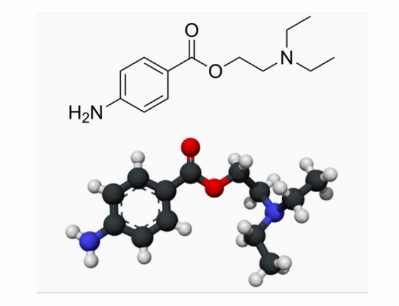
Properties
| Property | Description |
|---|---|
| Chemical Formula | C₁₆H₂₇ClN₂O₂ |
| Molecular Weight | Approximately 324.85 g/mol |
| Appearance | White or off-white crystalline powder |
| Solubility | Soluble in water, slightly soluble in ethanol |
| Melting Point | Approximately 175-177°C |
| Boiling Point | Decomposes before boiling |
| pH (of a 1% aqueous solution) | Approximately 4.5-6.5 |
| Stability | Stable under normal conditions |
| Pharmacological Properties | Local anesthetic properties, similar to lidocaine |
| Uses | Used for local anesthesia in dentistry and surgery |
Preparation of Amylocaine Hydrochloride
Amylocaine hydrochloride can be prepared synthetically through a series of chemical reactions. While the specific synthetic route may vary depending on the laboratory or manufacturer, here’s a general outline of the preparation of amylocaine hydrochloride:
- Acetylation of 2-diethylaminoethyl alcohol: The synthesis typically begins with the acetylation of 2-diethylaminoethyl alcohol. Acetylation involves reacting the alcohol with acetic anhydride or acetyl chloride in the presence of a base catalyst, such as pyridine. This reaction converts the alcohol group (-OH) into an acetate group (-OCOCH3).
- Reaction with 2,6-dimethylaniline: The acetylated product is then reacted with 2,6-dimethylaniline (also known as ortho-xylidine or OXA). This reaction typically occurs under acidic conditions, where the acetate group of the acetylated product is replaced by the 2,6-dimethylaniline group.
- Quaternization with Hydrochloric Acid: The resulting tertiary amine compound is then quaternized by treatment with hydrochloric acid (HCl). This reaction results in the formation of amylocaine hydrochloride, which is a water-soluble salt. The hydrochloride salt form enhances the compound’s solubility in water and improves its stability.
- Isolation and Purification: After the reaction, the amylocaine hydrochloride product is typically isolated and purified through techniques such as filtration, recrystallization, or chromatography. This ensures the removal of impurities and the production of a high-quality pharmaceutical-grade product.
- Characterization: The purity and identity of the isolated amylocaine hydrochloride are confirmed using analytical techniques such as nuclear magnetic resonance (NMR) spectroscopy, infrared spectroscopy (IR), and mass spectrometry (MS).
Uses of Amylocaine
Amylocaine hydrochloride, also known simply as amylocaine, is a local anesthetic drug belonging to the aminoamide class. It is primarily used for its anesthetic properties, often in dentistry and minor surgical procedures. Like other local anesthetics, amylocaine works by blocking nerve impulses in a specific area of the body, thereby numbing the region and reducing sensations of pain.
The hydrochloride salt form of amylocaine is more commonly used due to its improved solubility in water, which enhances its effectiveness as an injectable anesthetic solution. Amylocaine hydrochloride can be administered topically or via injection, depending on the intended application and the preference of the healthcare provider.